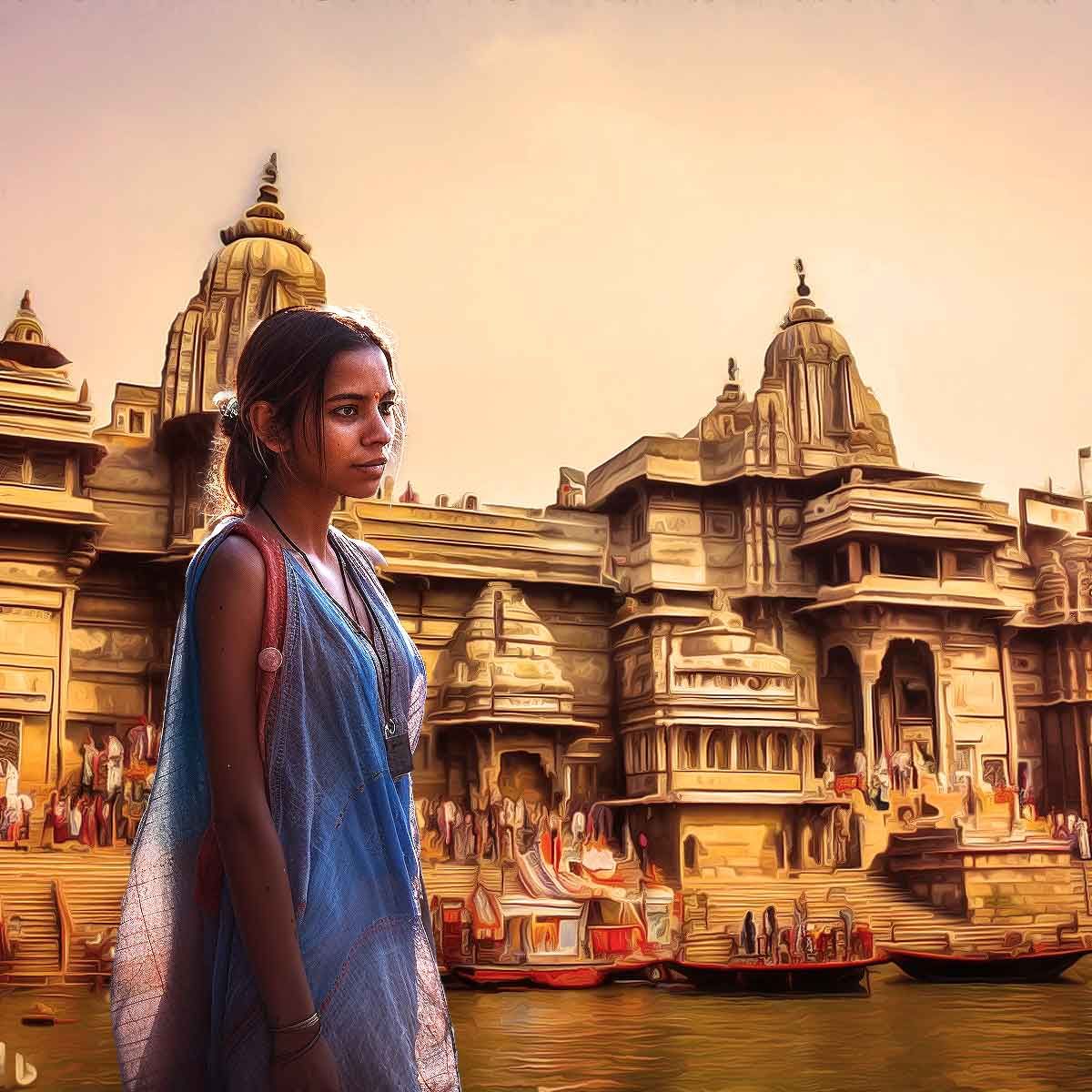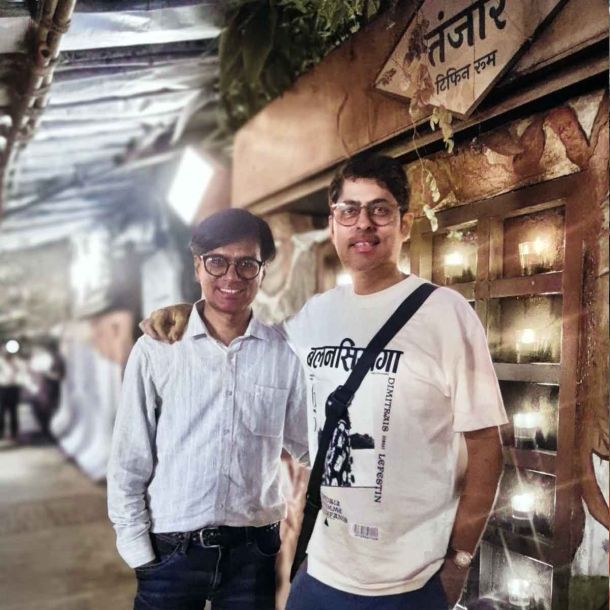More Coverage
Twitter Coverage
Satyaagrah
Written on
Satyaagrah
Written on
Satyaagrah
Written on
Satyaagrah
Written on
Satyaagrah
Written on
JOIN SATYAAGRAH SOCIAL MEDIA
"A city where life and death intertwine in harmony": Green Farewell for the Dead - Varanasi’s Manikarnika and Ghat to soon have eco-friendly cremation chambers harmoniously blending the latest and most advanced technologies with the traditional ethos

Steeped in spiritual reverence, vibrancy, and an indomitable spirit of conservation, the sacred city of Varanasi, fondly known as Benaras or Kashi, poised gracefully in the northern domain of Uttar Pradesh in India, is preparing to embrace a refreshing dawn of ecological consciousness.
The city, often hailed as the spiritual nucleus of India, reverberates with a rich historical tapestry dating back to the 11th century BC. It unfurls across a serene stretch of seven kilometers, kissed by the holy waters of the River Ganga, beckoning multitudes of devout pilgrims who flock to its awe-inspiring 23,000 temples. The city pulsates around the radiant heartbeat of the illustrious Kashi Vishwanath Temple, a monument of divine majesty and the cynosure of all worshippers.
A staggering number of visitors make the pilgrimage to Varanasi to solemnly perform the final rituals for their dearly departed at the 84 symbolic Ghats that adorn the banks of the Ganga. Of these revered ghats, five are considered paramount and two additional ones hold secondary importance. The Raja Harishchandra Ghat, in particular, commands the utmost veneration, for it is believed that the souls of those cremated here ascend directly to a state of eternal bliss and salvation, or Moksha, washing away the cycle of birth and death.
|
Manikarnika Ghat - The burning ghat of Varanasi
Enveloped in the folds of antiquity, the Manikarnika Ghat, one of the most ancient and revered among the ghats of Varanasi, is on the cusp of a transformative revolution. Soon, it will house a cutting-edge "greenatorium" that employs an environmentally conscious blend of wood and electricity within its chambers to cremate bodies, thereby paying homage to the dead whilst conserving Mother Earth. This sacred ground, or shamshan bhoomi, will also undergo a modern makeover, injecting a breath of fresh aesthetics into the spiritual landscape. Concurrently, the Harishchandra Ghat, another poignant cremation ground steeped in divine aura, will be outfitted with similar enhancements.
The Manikarnika Ghat, one of the oldest and most revered ghats in the spiritually rich city of Varanasi, stands as a profound symbol of divine transcendence in the intricate tapestry of Hinduism. Ancient scriptures within this faith have bestowed upon it the highest honour and regard, setting it apart from other ghats. It is deeply ingrained within the spiritual ethos of Hinduism that an individual who is cremated at this hallowed site immediately achieves moksha, a state of liberation or salvation, freeing their soul from the perpetual cycle of birth and rebirth.
Embraced on either side by the Scindia Ghat and Dashashwamedh Ghat, the Manikarnika Ghat is not just a geographical entity, but a sacred space steeped in spiritual lore and mystique. Like its counterparts in Varanasi, it is enwrapped in a captivating mythical narrative, revealing the fascinating origins of its unique moniker, Manikarnika.
Legend has it that the Divine Mother, Goddess Adi Shakti, also revered as Goddess Sati, in an act of supreme sacrifice, leapt into a ceremonial fire, immolating herself. Overwhelmed with grief, Lord Shiva, her divine consort, cradled her burning body and withdrew to the solitude of the Himalayas. His heart echoed with the resounding anguish of loss. Witnessing this inconsolable sorrow, Lord Vishnu, in an act of divine compassion, unleashed his celestial Chakra, a powerful divine weapon.
The Chakra, in its divine mission, cleaved the body of Goddess Adi Shakti into 51 fragments. These scattered pieces sanctified the earth wherever they fell, transforming these locations into revered Shakti Peethas, the sacred abodes of the Divine Feminine. As fate would have it, her earrings descended upon this very ghat, conferring upon it the status of a Shakti Peetha. The ghat was christened 'Manikarnika', a name derived from Sanskrit, where 'Manikarna' signifies 'earrings', thus immortalizing this divine event within its name.
This wave of modernization sweeping over Manikarnika Ghat, which solemnly oversees around 150 cremations each day, is a part of an extensive series of development ventures. These initiatives will be kickstarted by none other than Prime Minister Narendra Modi, who will either inaugurate these projects or lay the cornerstone during his two-day sojourn in his parliamentary constituency. Amid this whirlwind of progress, the Prime Minister will also address a public congregation in Kashi's Wazidpur, and initiate or establish the groundwork for an array of development endeavors worth Rs 12,000 crore, thus scripting a new chapter in Varanasi's majestic saga.
|
Redevelopment plan
Imbued with a devout spirit of reverence, transformation, and ecological conscientiousness, the Uttar Pradesh government has taken a monumental stride in the evolution of Manikarnika Ghat, recognized as the largest cremation ground in the world. This undertaking is nothing short of a rebirth for the revered ghat, the sacred resting place for countless souls making their final journey. In this grand scheme, the government has enlisted the expertise of Planner India, a renowned agency, to reimagine and reinvent the sacred cremation grounds of Kashi, with special emphasis on the Manikarnika Ghat.
Envisioned in the master blueprint for this spiritual and ecological revival, the first notable change that will be ushered in is the installation of a groundbreaking 'greenatorium.' This innovative concept signifies the dawn of a new era in the customs and rituals associated with the sacred act of cremation.
Under the auspices of the Uttar Pradesh government, the Manikarnika Ghat, one of the oldest and most respected ghats of Varanasi, is poised to become the site of these pioneering green crematoriums. Termed as 'greenatoriums', these establishments will mark a significant shift towards more environmentally sensitive methods of cremation, harmoniously blending tradition and sustainability.
The concept of a 'greenatorium' marries the elemental rawness of traditional wood pyres with the efficiency and cleanliness of modern electric heaters. This symbiosis occurs within specially designed chambers where the bodies are cremated. The introduction of these innovative greenatoriums not only respects the sanctity and customs associated with cremation but also ensures a reduced ecological footprint, heralding a new chapter in the history of Manikarnika Ghat and paving the way for a greener and more sustainable future for this sacred site.
An authority from the project offers a detailed glimpse into the intricacies of this revolutionary cremation system. With a thoughtful blend of tradition and technology, the process employs a harmonious combination of wood and electric cremation. Here, the mortal remains of the deceased are gently placed on a traditional wooden pyre, not under the open sky, but within a specially designed chamber. This architectural marvel, a product of cutting-edge technology and environmental consciousness, ensures that harmful gases and excessive heat generated during the cremation process do not escape into the atmosphere, thereby minimizing environmental harm.
The electric heater plays a crucial role in facilitating the cremation process, generating the heat required to consume the body. However, what sets this process apart from conventional methods is the ingenious treatment of residual gases. Instead of being released directly into the atmosphere, these gases are skillfully transformed into vapor, thereby significantly reducing their ecological impact.
In addition to pioneering the greenatoriums at the revered Manikarnika Ghat, Planner India, the agency entrusted with this monumental task, is committed to bringing a series of other enhancements to the sacred site. Among the planned improvements is the construction of a 'wood plaza.' This would not only serve as a dedicated space for procuring the sacred wood used for the pyres but also infuse an added layer of organization and aesthetics into the age-old cremation rituals.
Comprehending the importance of accommodating the numerous visitors that flock to this holy site, plans are also underway to erect a shelter, ensuring comfort and respite to the visitors amid their spiritual pursuits. Furthermore, in an endeavor to meet the ever-increasing demand for cremation spaces, the agency plans to establish more cremation bases along the serene banks of the Ganga.
Recognizing the practical needs of visitors, the redevelopment plan also features the provision of adequate parking facilities, ensuring a hassle-free experience for visitors. Likewise, changing facilities are also part of this comprehensive renovation plan, further enhancing the overall experience for those who partake in the sacred rituals at the ghat. In its entirety, the initiative promises not only a rejuvenated and eco-conscious Manikarnika Ghat but also a holistic and elevated experience for its visitors.
|
Reimagining the Heritage: Beautification of Surrounding Structures
During a Saturday briefing, a representative from the state government enthusiastically shared that there is an ongoing mission-mode initiative to refurbish the Manikarnika Ghat. This iconic landmark, he stated, is destined to become even more accessible and modernized, aligning it with the comforts of the 21st century while maintaining its ancient spiritual aura. "This renaissance of the Manikarnika Ghat will be facilitated through Corporate Social Responsibility (CSR) funds," he further elucidated.
The intricate plan of beautification isn't limited to the ghat itself but expands to encompass the adjacent Manikarnika Kund and the venerable Ratneshwar Mahadev temple. The spokesperson noted that many individuals, especially from Bihar, Chhattisgarh, and Purvanchal, come to Manikarnika Ghat to perform the solemn last rites for their departed loved ones. To honour this deep-rooted spiritual connection, the Yogi Adityanath-led government has envisioned a comprehensive redevelopment of Manikarnika Ghat, extending to the heritage buildings and temples in its vicinity.
Reflecting the timeless architectural heritage of the region, the buildings from Manikarnika Ghat to the Tarakeshwar temple will be reimagined in the iconic Nagara style, the spokesperson revealed. The plan includes three stories of construction reaching up to the Tarakeshwar Mahadev temple and extending all the way to the Dattatreya Paduka, a distance spanning 300 to 400 meters. The official associated with the planning and design of this ambitious project estimated the cost to be a substantial Rs 17.56 crore.
This remarkable makeover is not exclusive to Manikarnika Ghat. Both Harishchandra Ghat and another cremation ground in Varanasi are also slated for similar transformative experiences. In addition to the beautification of these sacred spaces, Prime Minister Modi will be marking the commencement of the much-anticipated Gorakhpur-bound Vande Bharat Express train.
|
The Prime Minister's Infrastructure Revolution during his Two-Day Visit
Prime Minister Narendra Modi's upcoming visit to Uttar Pradesh on July 7 promises to be a remarkable event. His agenda includes the initiation of multiple projects, including the long-awaited redevelopment project at Manikarnika Ghat. The Prime Minister's commitment also extends to other initiatives worth a staggering Rs 12,000 crore in his home constituency, Varanasi.
These projects include the construction of 18 PWD roads, the development of an international girls' hostel at the esteemed Banaras Hindu University, and the establishment of the Central Institute of Petrochemical Engineering and Technology at Karsara village. The Prime Minister will also be inaugurating rural drinking water schemes under the Jal Jeevan Mission, aiming to provide pure drinking water to over seven lakh individuals in 192 villages, with a generous budget exceeding Rs 550 crore.
The Prime Minister's visit will also witness the commencement of the distribution of PMSVANidhi loans, keys to PMAY rural houses, and Ayushman Bharat cards to the deserving beneficiaries in the state. This will mark the 'griha pravesh' for five lakh PMAY beneficiaries, the allocation of 1.25 lakh PMSVANidhi loans, and the distribution of a colossal 2.88 crore Ayushman cards.
In all, the Prime Minister's two-day visit to Uttar Pradesh signifies a resolute step towards progress, development, and the holistic uplifting of the lives of its citizens, while honouring and preserving the cultural and spiritual ethos of the region.
 Support Us
Support Us
Satyagraha was born from the heart of our land, with an undying aim to unveil the true essence of Bharat. It seeks to illuminate the hidden tales of our valiant freedom fighters and the rich chronicles that haven't yet sung their complete melody in the mainstream.
While platforms like NDTV and 'The Wire' effortlessly garner funds under the banner of safeguarding democracy, we at Satyagraha walk a different path. Our strength and resonance come from you. In this journey to weave a stronger Bharat, every little contribution amplifies our voice. Let's come together, contribute as you can, and champion the true spirit of our nation.
 |  |  |
| ICICI Bank of Satyaagrah | Razorpay Bank of Satyaagrah | PayPal Bank of Satyaagrah - For International Payments |
If all above doesn't work, then try the LINK below:
Please share the article on other platforms
DISCLAIMER: The author is solely responsible for the views expressed in this article. The author carries the responsibility for citing and/or licensing of images utilized within the text. The website also frequently uses non-commercial images for representational purposes only in line with the article. We are not responsible for the authenticity of such images. If some images have a copyright issue, we request the person/entity to contact us at This email address is being protected from spambots. You need JavaScript enabled to view it. and we will take the necessary actions to resolve the issue.
Related Articles
- Temple city Madurai grandly celebrated the Chithirai festival, devotees thronged streets, got darshan of deities Meenakshi, Sokkanathar, and Kallazhagar: “Govinda” “Hara Hara” chants reverberated in Madurai with pomp
- The Calculated Destruction of Indian Gurukuls (Education System) by British Raj which resulted in the tormented Indian Spirit
- Mahakal Temple in Ujjain to get expanded complex with Rs 714 crore in such a way that there will be a feeling of grandeur and divinity: Another reason for devotees to celebrate after Kashi Vishwanath corridor
- PM Modi inaugurates rebuilt Shankaracharya samadhi in Kedarnath and said ‘Adi Shankara brought life to a sleeping civilisation, awakened Bharat to rise above caste boundaries’
- "You don't have a soul. You are a Soul. You have a body": Anything lost, any work to be done, or any issue to be solved; first and foremost, people recall this divine 'Koragajja', one of the most sacred, worshipped, and sought-after spirits in Tulunadu
- 'Preserving state’s Cultural Heritage is important so Non-Hindus in Char Dham Yatra will have to undergo verification': Uttarakhand CM Pushkar Singh Dhami after concerns raised by Hindu religious seer
- After removing 500 tons of garbage, 18th-century old stepwell to soon serve with clean, fresh groundwater gushing from 53 feet deep water stream: Nalla Pochamma Temple, Telangana
- 'Older than history, older than tradition, even older than legend...': The millennia-old history of Kashi
- ‘Lord Shiva helps creation sprout even from ruins, Humanity always wins over terrorism’: PM Modi launches key projects at Somnath
- For the first time in the history of Puri Srimandir, 40 to 100 earthen hearths in the kitchen of Shree Jagannath Temple of Puri in Odisha were vandalized inside the Rosa Ghara
- 'Any direction issued by CM Yogi is a ‘sant vachan’ and we are bound to follow his directions': Shri Krishna Janmabhoomi Trust in Mathura stops using loudspeakers following Yogi Adityanath’s guidelines
- Now Bharatwasi can see 3D visualization of Ram Mandir construction progress in detail through a video released by Shri Ram Janmabhoomi Teerth Kshetra Trust: Ayodhya
- A new symbol of Hindutva pride, Shri Kashi Vishwanath Temple Corridor
- RTI reply revealed that keys to the treasure room 'Ratna Bhandar' of Puri Jagannath temple which has a lot of gold, silver, and precious jewels donated by devotees and kings over the centuries have been ‘missing’ since 1970: Odisha
- For the first time in the history of Tirupati, 30 devotees on foot stopped from reaching temple for carrying musical instruments up Tirumala hill by TTD: Devotees perform Nama Sankeerthanam during the journey




























